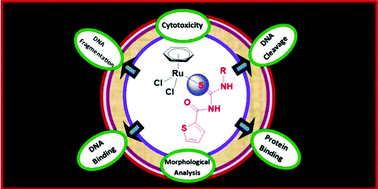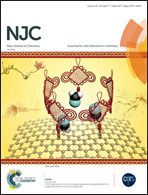Synthesis of Ru(ii)–benzene complexes containing aroylthiourea ligands, and their binding with biomolecules and in vitro cytotoxicity through apoptosis†
Abstract
The reaction of [RuCl2(η6-benzene)]2 with aroylthiourea resulted in the formation of Ru(II) complexes of the type [RuCl2(η6-benzene)L] (L = monodentate aroylthiourea ligand). The complexes were well characterized using UV-Visible, FT-IR, NMR and mass spectroscopic techniques. Single crystal X-ray diffraction confirmed the monodentate coordination of the ligand through a sulfur atom. The interaction of the Ru(II) complexes with calf thymus DNA (CT DNA) was investigated using UV-Visible and fluorescence spectroscopic methods, and viscosity measurements. The binding ability of the complexes with bovine serum albumin (BSA) was explored using UV-Visible and fluorescence experiments. The results showed that the complexes interact with the biomolecules with appreciable binding constants. The gel electrophoresis technique was used to demonstrate the unwinding of the supercoiled DNA to its nicked form. The cytotoxicity of the Ru(II) complexes was screened for a panel of cancer cell lines like HepG2, A549, MCF7 and SKOV3. Complexes 1, 2 and 3 showed modest activity at the concentration of 31.25 μg mL−1 against HepG2 cells. Complexes 1 and 3 displayed moderate cytotoxicity at the concentration of 62.5 μg mL−1 against A549 and SKOV3 respectively. Low cytotoxicity was observed for all the complexes against MCF7. Advantageously, complexes exhibited only less toxicity against Vero normal cells. Further DNA fragmentation, flow cytometry and fluorescence staining [DAPI (blue), FITC (green) and PI (red)] for the detection of apoptosis in HepG2 cells were carried out. The above methods demonstrated that the complexes have a significant ability to induce cell death by apoptosis.



 Please wait while we load your content...
Please wait while we load your content...